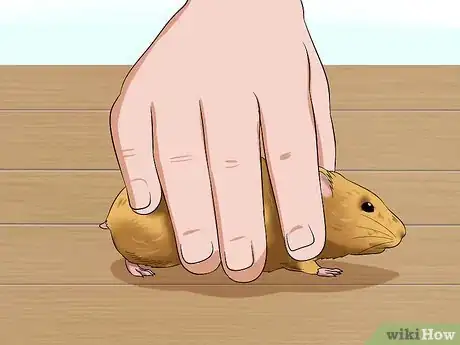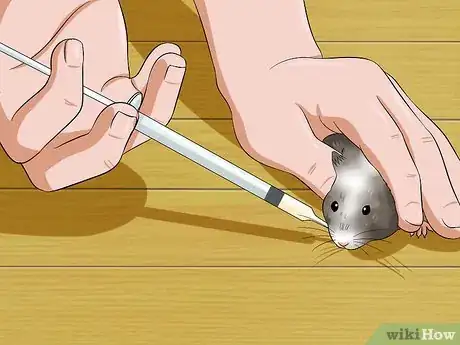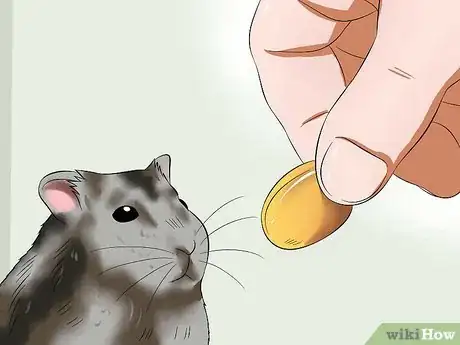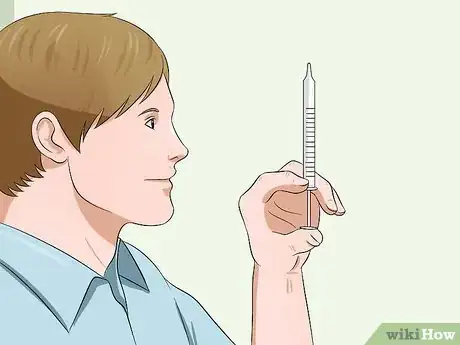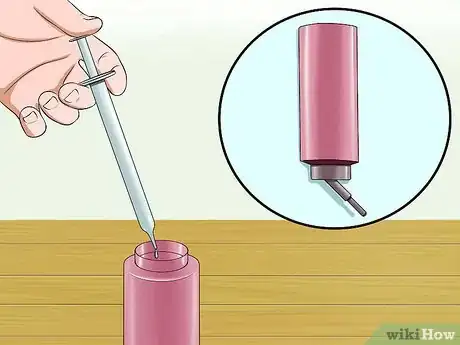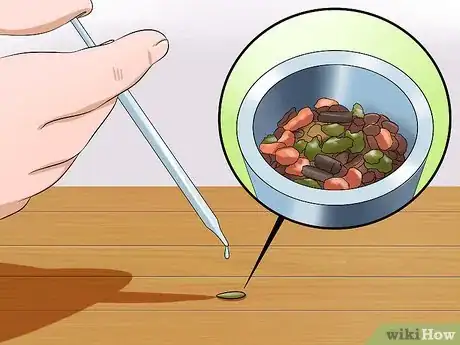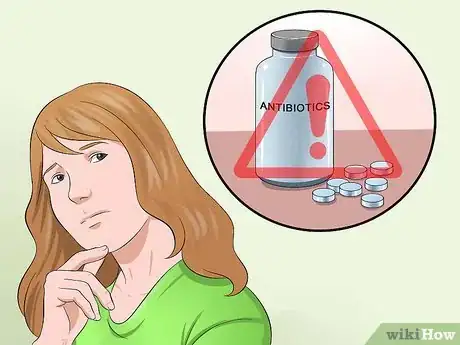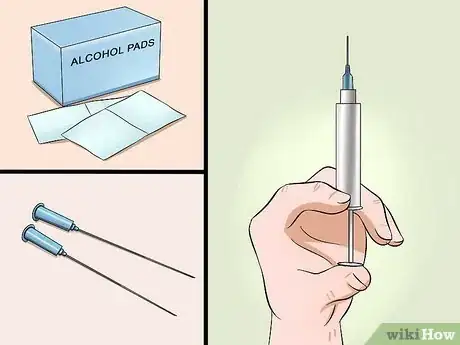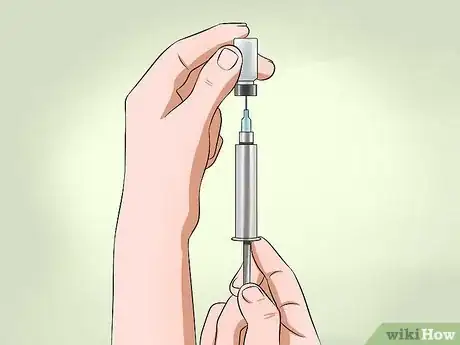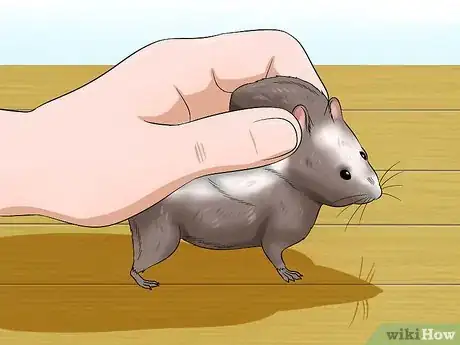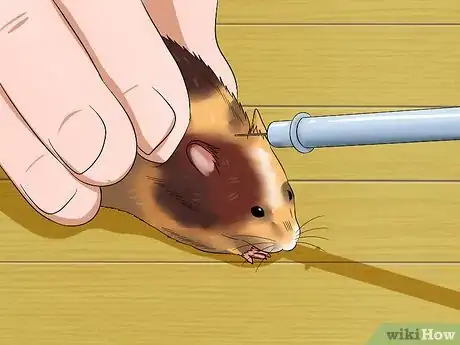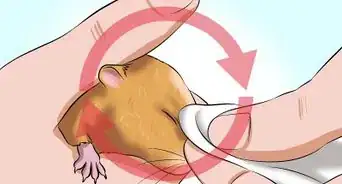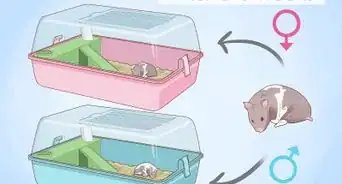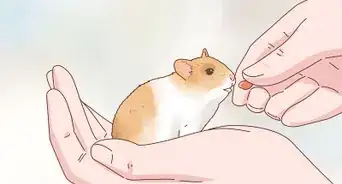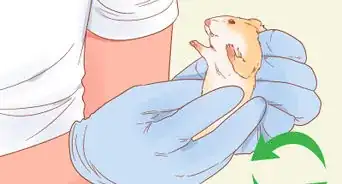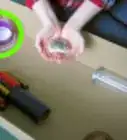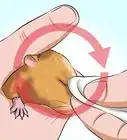This article was co-authored by Pippa Elliott, MRCVS. Dr. Elliott, BVMS, MRCVS is a veterinarian with over 30 years of experience in veterinary surgery and companion animal practice. She graduated from the University of Glasgow in 1987 with a degree in veterinary medicine and surgery. She has worked at the same animal clinic in her hometown for over 20 years.
This article has been viewed 36,424 times.
Have you noticed changes in your hamster's appearance or behavior? Is it less active or having trouble walking or breathing? Like people, hamsters get sick and sometimes need medical care. Talk to the pet's veterinarian for advice. She will be able to recommend a course of therapy and tell you how best to deliver the hamster's medicine, whether orally, in food or water, or by injection.
Steps
Administering Medicine Orally
-
1Find a good spot. Pick a place where you can safely administer medicine to your ailing hamster. Your hamster might be most comfortable on the floor. Avoid using tabletops or counters, because the animal could fall and be seriously injured. Also make sure that there are no nearby glasses, knives, or other sharp objects.[1] [2]
- Once you've found a spot, begin to set out your materials. This might include the bottle of liquid medicine, an eyedropper or syringe, and a clean towel.
-
2Prepare the medicine. Oral medication is usually given to hamsters in liquid form, with a small syringe or dropper. Make sure that you have a dropper as well as the bottle prescribed by your veterinarian.[3]
- First, read the directions on the bottle of medicine. Look closely for the proper dosage.
- Take the bottle of medicine and give it a shake, if need be. Then, open the bottle and insert the dropper.
- To draw the medicine, either pull back on the syringe's plunger or press the dropper's rubber bulb. This will create suction and fill the plastic tube with medicine.
- Make sure that you draw the proper dosage. Hold the tube level and look at the measuring scale to check the amount.
Advertisement -
3Restrain the hamster if need be. Some hamsters can be tempted to take medicine right from the dropper, so long as the taste is not too foul. You may have to restrain your pet, however. There are several humane ways that you can do this.
- One way is to hold the animal down with the palm of your hand. Gently but firmly cup your palm and put it over the hamster's body, so that it cannot move and only its head is free.[4] Your other hand will be free to administer the meds.
- Use a towel to swaddle the hamster, alternately. Just wrap the animal so that its paws are inside the towel and its head is sticking out. Hold the animal with one hand.
- You can also “scruff” the animal. Hamsters have lots of loose skin around the neck and front of the shoulders, which you can grab with your thumb and forefinger.[5] Just be aware that too much tension on the scruff can cause the hamster's eyes to pop out. Have your vet show you a safe way to scruff the hamster before attempting this at home or use a different method.
-
4Administer medicine. Take the dropper with your free hand, while continuing to restrain the hamster. Hold the dropper to the animal's mouth and, if it licks the tool, gently push the medicine out.
- The hamster might not be cooperative. It may squirm and resist. In that case, first, try to insert the mouth of the dropper into the side of the animal's mouth where it has no teeth. Squeeze the medicine out and it will be swallowed.
- Do not try to open the hamster's mouth with your fingers. While this can be done by pulling up at the mouth, making the animal “smile” and exposing gaps, you can also be bitten.
-
5Reward your hamster. Taking medicine orally can be an unpleasant experience for your hamster. The liquid may taste bitter, and being restrained is traumatic. Reward your pet for good behavior and to help calm it, such as some sunflower seeds.
- A piece of food may also cleanse the palette if the medicine was bitter.
Dissolving Medicine in Food or Water
-
1Measure the proper dosage. Medicine in food or water is easier to administer to your hamster but, at times, less effective. On one hand, you're “hiding” the meds and do not have to handle the animal. On the other, it is hard to keep track of consumption, and the animal might taste the medicine and avoid eating or drinking.[6]
- Take the medicine bottle and measure out the correct amount with a small dropper.
- Again, follow your veterinarian's instructions and be sure you have the exact dosage. Hamsters are small animals and can easily overdose.[7]
-
2Dissolve the medicine in water. If the veterinarian has suggested it, you might be dissolving meds into your hamster's water supply. Take the animal's water bottle from the cage and open it.
- Fill the bottle with water and add the medicine from the dropper. You will need to make sure that the meds are fully dissolved and well-mixed and that they are changed daily.[8]
- Use only purified, de-ionized water. No tap water.[9]
- Monitor your pet closely once you have returned the bottle to the cage. Make sure that the animal continues to drink normally.
-
3Dissolve the medicine into food, alternately. Place the proper amount of drops onto a piece of your hamster's food and then offer the food to the animal. You might place it directly into the cage, or you can tempt the hamster with the treat from your hand.
- Hamster pellets are small. It might take you quite a few of them to administer the medicine, depending on the dosage.
- Bribing the animal with a special, medicine-laced treat – like baby food – is another idea. Put a small amount of food with the full dose on the spoon, and let the animal eat until it is gone.
-
4Be cautious if administering antibiotics. Hamsters are sensitive to anti-biotics, which change the microbial balance of the animal's intestines and can kill it. If the vet has prescribed antibiotics, follow her instructions to the letter.[10]
- Rest assured that your veterinarian is aware of the risk of antibiotics and will prescribe the safest medication for your hamster.
Giving Your Hamster an Injection
-
1Get instructions from your vet. Although giving medicine orally is easier and less expensive, “parenteral administration,” i.e. a shot, is often a more effective method. Your vet will tell you if this is the best way. Also, some medicines can't be given to hamsters orally.[11]
- Ask the doctor for step-by-step instructions if you have to give the shot yourself. It is not particularly hard, but you must be able to do it correctly.
- Try to have the vet write down the instructions on paper, if possible. This will allow you to refresh your memory at home.
-
2Prepare your site and supplies. Beforehand, take the syringe and other supplies to draw out the correct dosage of medicine. Besides the syringe, you will need the vial of meds the vet gave you, an alcohol pad, and a needle or sharp. Like before, set up shop in a safe place.
- Read the instructions closely before going ahead. As always, you must be careful to get the right amount to avoid an overdose.
- Take the cap off the vial and wipe the top with an alcohol pad to sterilize it.
-
3Draw the medicine. Hold the syringe in your hand like a pencil and take the protective cap off the needle. Pull back the plunger to the line on the scale for your dosage. This will fill the tube with air.[12]
- Next, hold the vial right side up, push the needle through the rubber top, and push out the air. Doing so will keep a vacuum from forming.
- Turn the vial upside down so that the needle is in the medicine. Then, pull back on the plunger to your dosage amount. Remove any trapped air bubbles by tapping on the syringe with your fingers, and gently push the plunger to expel them from the tube.
- Remove the needle from the vial. Keep it sterile. If you have to set the syringe down, be sure to cover the needle with the protective cap.
-
4Restrain the hamster. Carefully and gently take your pet from the cage. You may want to clear out obstacles like exercise wheels and food dishes so that the animal cannot evade you. The best way to give a shot to a hamster is by scruffing.
- Again, gently pinch the scruff between your thumb and forefinger and pull it taut. Then, turn the animal over while supporting its body with your palm. The hamster should be immobilized.
-
5Administer the shot. Take the syringe with your free hand and remove the protective cap. Hold the animal steady and prepare to deliver the medication.
- For a shot into the body cavity (called an intraperitoneal injection), wipe the lower left part of the abdomen with the alcohol wipe and let it dry.
- Tip the animal so that its nose is pointing down a bit and insert the needle at a 30-degree angle in the sterilized area. Push the plunger to inject the medicine and then remove the needle.
- For a shot under the skin (called a subcutaneous injection), lightly pull up the skin over the injection site to make a small pocket. Sterilize the pocket with alcohol and insert the needle.
- Retract the plunger. If you see any blood or fluid, reposition the needle. Repeat. When you have found a good site, push the plunger to inject the medicine and remove the needle.
- Return the animal to its cage when you are done.
Expert Q&A
-
QuestionIs this the same with guinea pigs?
 Pippa Elliott, MRCVSDr. Elliott, BVMS, MRCVS is a veterinarian with over 30 years of experience in veterinary surgery and companion animal practice. She graduated from the University of Glasgow in 1987 with a degree in veterinary medicine and surgery. She has worked at the same animal clinic in her hometown for over 20 years.
Pippa Elliott, MRCVSDr. Elliott, BVMS, MRCVS is a veterinarian with over 30 years of experience in veterinary surgery and companion animal practice. She graduated from the University of Glasgow in 1987 with a degree in veterinary medicine and surgery. She has worked at the same animal clinic in her hometown for over 20 years.
Veterinarian Some of the methods of holding a guinea pig to give medicine are not the same as for the hamster. Never try to hold a guinea pig by the scruff, as this will distress it. However, hamsters and guinea pigs are alike in that they have a gap between the front incisors and the chewing molars at the back, which is useful place to put the hub of a syringe when giving liquid medicines. Never try to raise guinea pigs' heads or hold them on their backs, as again, this is distressing to them.
Some of the methods of holding a guinea pig to give medicine are not the same as for the hamster. Never try to hold a guinea pig by the scruff, as this will distress it. However, hamsters and guinea pigs are alike in that they have a gap between the front incisors and the chewing molars at the back, which is useful place to put the hub of a syringe when giving liquid medicines. Never try to raise guinea pigs' heads or hold them on their backs, as again, this is distressing to them.
References
- ↑ http://www.merckvetmanual.com/pethealth/exotic_pets/hamsters/routine_health_care_of_hamsters.html
- ↑ http://rabbit.org/faq-medicating-your-rabbit/
- ↑ http://www.merckvetmanual.com/pethealth/exotic_pets/hamsters/routine_health_care_of_hamsters.html
- ↑ http://www.ahwla.org.uk/site/tutorials/BVA/BVA04-Hamster/Hamster.html
- ↑ http://www.ahwla.org.uk/site/tutorials/BVA/BVA04-Hamster/Hamster.html
- ↑ http://www.vspn.org/vspnsearch/aow/drugtherapyinpetrodents.htm
- ↑ http://www.merckvetmanual.com/pethealth/exotic_pets/hamsters/routine_health_care_of_hamsters.html
- ↑ http://www.vspn.org/vspnsearch/aow/drugtherapyinpetrodents.htm
- ↑ http://www.vspn.org/vspnsearch/aow/drugtherapyinpetrodents.htm


